Psst… if you can’t see the video above, then click here to check it out on the main site!
“There likewise I beheld Excalibur
Before him at his crowning borne, the sword
That rose from out the bosom of the lake,
And Arthur rowed across and took it—rich
With jewels, elfin Urim, on the hilt,
Bewildering heart and eye—the blade so bright
That men are blinded by it”
-Alfred, Lord Tennyson; “Idylls of the King”
If there’s one piece of kitchen gear that will get you cooking faster than anything else, it’s a good all-purpose knife.
I always chuckle when I read guides for beginning cooks on stocking a kitchen that include a whole slew of knives.
Unless you work in a restaurant or as a caterer, you only need one knife.
For most people, this “one knife to rule them all” is an 8-inch chef’s knife.
You can slice, dice, mince, and chop anything with just this knife. The only essential cutting skill a chef’s knife sucks at is peeling. But a great peeler will set you back five bucks or less, so don’t sweat it, homeslice.
A chef’s knife is the Excalibur of your kitchen. Without it you are powerless to make any meal, but with it you are an unstoppable force to be reckoned with.
Chef’s Knife Buyer’s Guide
Most cooks will tell you to go out and buy an expensive chef’s knife, and I agree…
…but only if you can afford it AND you have done your homework.
Knives can get expensive real quick, and if you don’t know what to look for, you’ll probably end up going home with a super expensive hunk of steel that may or may not be any good.
If you are on a limited budget (or are just interested in dipping your toe into the cooking waters), it’s much better to start out with a $5-$10 knife from Target or Ikea to learn the basic skills before moving on to a nicer model when you are ready.
(I used dirt cheap knives for almost 15 years, and only recently upgraded to a “nice” knife that I expect to use the rest of my life.)
Yes, those cheap knives pale in comparison, but I might not have ever learned how to cook otherwise.
If you have the funds and the dedication, these are the two things that matter in a chef’s knife:
- A super-sharp edge
- A well-balanced feel in your hand
The sharper your knife, the easier it is to control, and the less likely you are to slip and cut yourself.
A well-balanced knife is one that feels like it was custom-made for your hand. It allows you to easily do everything from dicing potatoes to mincing garlic without putting unnecessary strain on your hand or wrist.
Now, the only way you’ll really be able to determine these is if you can actually use the knife before buying. Unless you are shopping and the kind of badass store that will let you do that, you might be up a creek.
…but there’s also this thing called the internet.
Fortunately for you, the world wide interwebs is an excellent place to find reviews for knives. So you can shop without any high-pressure salesmen hovering around and read what real people have to say about it.
The heavyweights of the chef’s knife world are the German companies Wüsthof (gotta love the heavy metal name!) and Henckels, which always tend to get great reviews.
But I have never used anything from either of these brands. I’m sure they make great stuff, but I’ve found their product lines too be a bit too large, expensive, and anxiety-inducing to ever consider them too seriously.
The knife I settled on was the Global G–2, which always ends up on lists of the greatest knives out there, while usually costing less than the competition. (I found mine on Amazon for about $100.)
But if you’ve got a little more than $10 to spend on a knife, but can’t quite stomach dropping a c-note, you might want to check out the Victorinox Fibrox chef’s knife.
This is another knife that consistently makes it into the top chef’s knife lists, and you can find them online for about $25.
If you’re interested in delving a bit deeper into all of this, I’d strongly suggest checking out Cooking for Engineers’s chef’s knife guide to learn all you’d ever want to know about finding a good piece of steel.
But no matter which way you go, take the time to do some research online about whatever knife you’re eyeing up before you pull the trigger. That’s what it’s there for.
One last note. A chef’s knife isn’t technically the only knife you can use as your all-purpose kitchen tool.
Due to the heavy European influence in English-speaking countries (and thus the readers of this site), the traditional French chef’s knife is the easiest knife to buy and learn about, but other cultures use different styles that are just as solid as well.
The Japanese santoku, with its flatter blade, seems to be catching on these days in the States and is becoming increasingly easier to find.
The Chinese chef’s knife, which looks like a small meat cleaver, is much less common in the West, but is the go-to knife for more than a billion people.
Although different cultures use slightly different knives, they all have large blades and are versatile enough to serve as the only cutting instrument that most home cooks need.
Knife Care
There’s three things to keep in mind if you bought a good knife and want it to last forever:
- Wash and dry it by hand
- Store it safely
- Sharpen or hone it periodically
Unlike your Garfield coffee mugs and Tony the Tiger cereal bowls, your kitchen knife shouldn’t get tossed in the dishwasher, where it will just get dinged up and lose its edge.
Instead, wash and dry the knife by hand every time that you use it.
You’ll also want to store it in such a way that the blade is protected. The most popular method is to store it in a knife block, but those things tend to hold all sorts of nasty bacteria where you’ll never be able to clean them. Plus, if you only have one knife, then what in the world would you want to do with a big wooden block?
I like to wrap mine up in a big, thick dish towel and store it in a drawer.
Lastly, you’ll want to sharpen or hone it on a regular basis. Keeping the blade sharp will not only help it last longer, but will also help you to use it more safely.
Most people get a honing tool, which is intended to be used before each use (or damn near). Honing tools don’t remove any of the steel, but rather “smooth” it out and move any dented-up parts of the blade back into place.
Sharpening tools, on the other hand, remove some of the metal in order to create a brand-new edge, and should be used more sparingly. Most people send out their knives to be professionally sharpened (if they do it at all), but you can give it a shot yourself if you’re feeling adventurous, using a whetstone or a tool such as the Spyderco Tri-Angle Sharpmaker System.
Using the Knife Safely and Effectively
There are three “ninja skills” that you must learn if you want to use your knife well without chopping off a fingertip.
- How to hold the knife
- How to hold the food
- How to cut the food with the knife
You might be tempted to just hold the knife like you would hold a hammer. Please don’t.
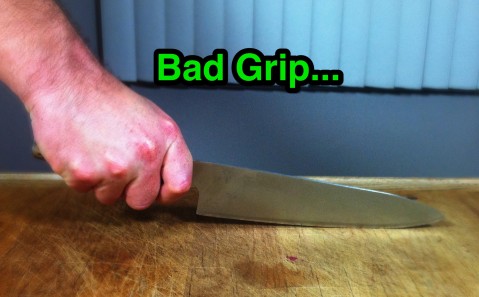
If your knife is built well, it will be perfectly balanced between the blade and handle. In this case, you’ll want to have fingers on both sides in order to increase the control you have over the blade.
It might feel weird at first, but choke up on the blade, pinching it between your index finger and thumb. Your middle finger should wrap around the handle right behind the blade (at the balance point), and your ring and pinkie fingers wrapped around the handle behind it.
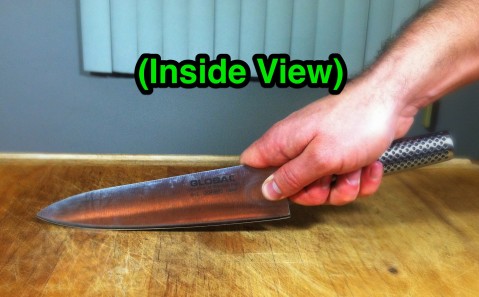
By using this grip, the knife should be perfectly balanced in your hand, and will thus be easiest to control. You should officially feel like some kinda badass ninja at this point.
The biggest risk of injury comes to the hand holding the food. The last thing you want to do is leave your fingertip on the cutting board when you’re dicing onions for guacamole.
The ideal holding position has these three characteristics:
- The fingertips are held far away from the blade.
- The knuckles are held high to use to guide the blade.
- The hand is stabilized.
For the sake of your fingers, you need to learn something known as “the claw.”
The claw is performed as such:
- Turn your hand inwards 90 degrees so that your fingers are pointing at the blade.
- While holding the food with your fingertips, curl all your fingers so that the knuckle of your middle finger is the closest part of your hand to the knife.
- Depending on what you are cutting, you may want to rest the heel of your hand on the food or cutting board for added stability. I’ve found that this works best for unstable foods and delicate tasks such as mincing. If you lift the heel of your palm up, you will have less stability, but you will also be able to use your second knuckle to guide the blade, putting more distance between the blade and your fingertips.
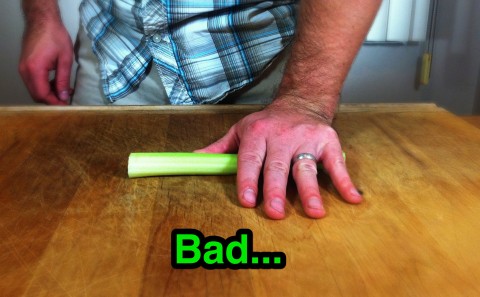
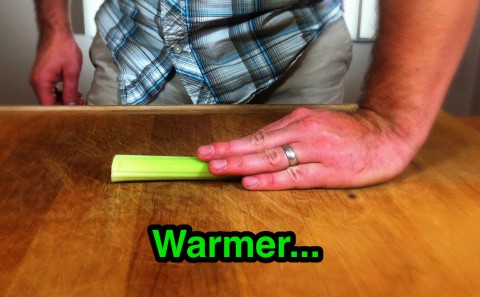
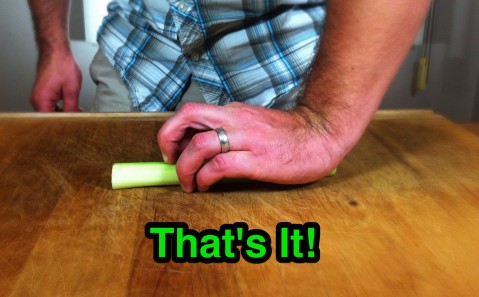
Alright, now you know how to hold both the knife and the food, it’s time for the rubber to hit the road and put the two together.
Keep the following points in mind when you are cutting anything:
- Use a circular cutting motion, with part of the blade always touching the cutting board. This is safer than hacking up and down and more efficient as well due to the added forward-and-back motion.
- Make sure your middle finger knuckle is always the closest part of your holding hand to the blade. (Watch out for those fingertips!) And use this knuckle as much as possible to guide the blade.
- Depending on what you are cutting, you will either need to move the food or the knife forward as you move your holding hand back. Make sure you keep your fingers curled and your middle finger knuckle forward.
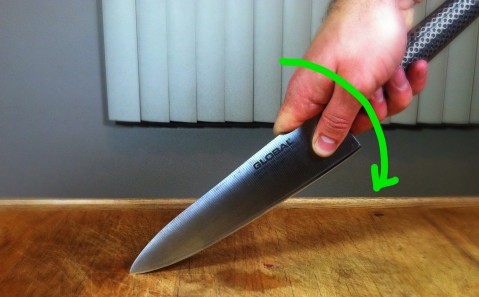
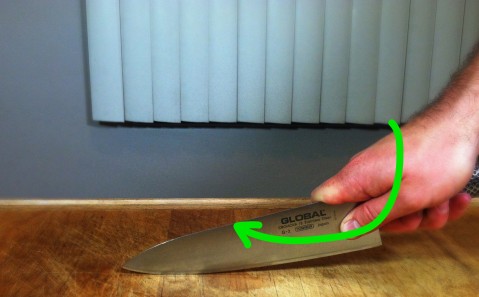
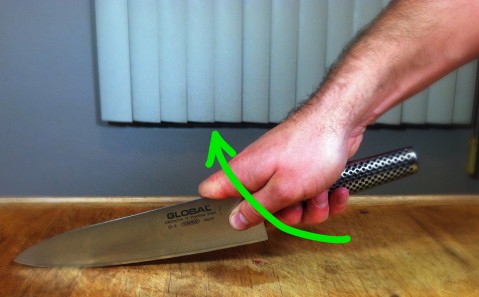
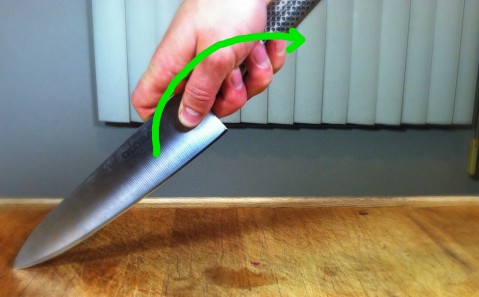
Take your time doing this at first to learn how to do it right. You will naturally speed up over time, and your fingers will be forever grateful.
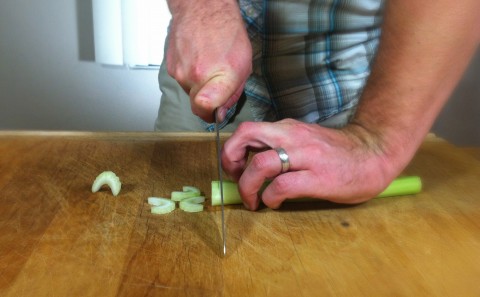
One Knife to Rule Them All
King Arthur used the legendary sword Excalibur to blind his enemies and defend Britain against the invading Saxons.
In learning how to cook, you will have to face down many fears, none of which are any less intimidating than these medieval warriors.
But learning how to properly wield a chef’s knife will be the most important skill you can learn in order to master cooking.
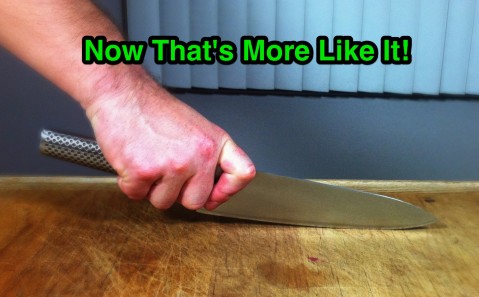
 I'm a science geek, food lover, and wannabe surfer.
I'm a science geek, food lover, and wannabe surfer.
{ 2 comments }
Darrin,
I think it’s definitely time for a new knife for me. Thanks for the suggestions. By the way, the video looks awesome great job!
Alykhan
Thanks man! More epic vids to come…
Comments on this entry are closed.